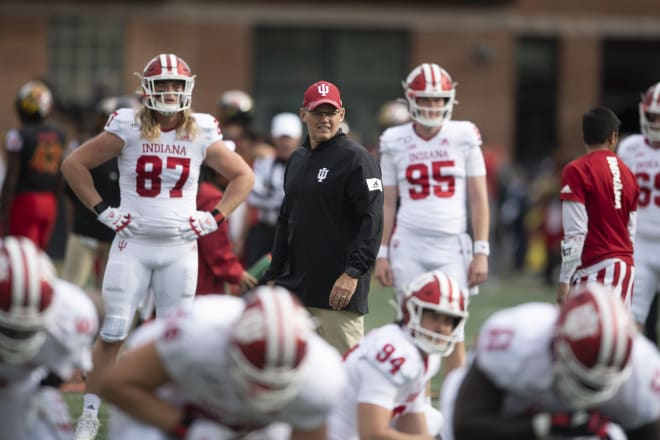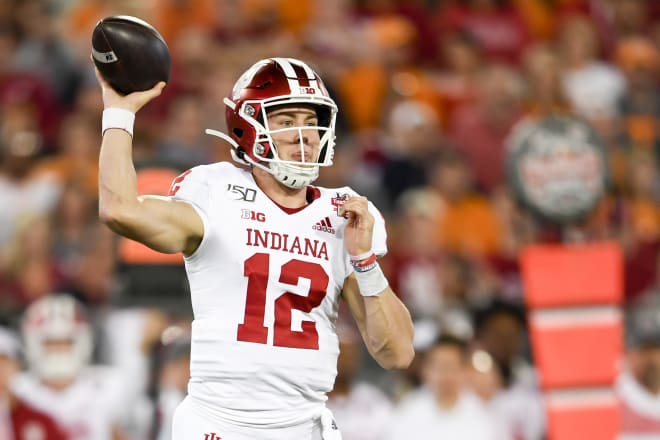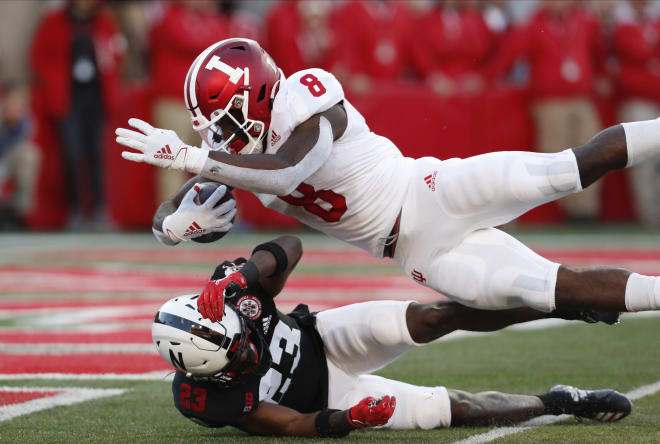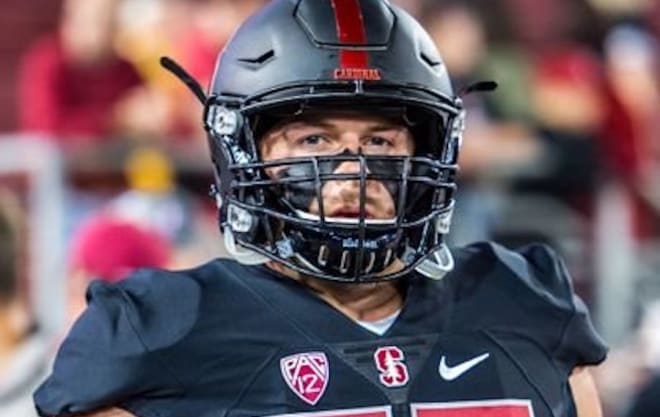Around the Big Ten East: Indiana
Last season was one of history for Indiana – the best season of the last 26 years in Bloomington. The Hoosiers hadn’t put together an eight-win season since 1993 and were moments away from the program’s third nine-win season and the first bowl win since 1991 before Tennessee took the lead late in the TaxSlayer Gator Bowl on Jan. 2.
Regardless, Tom Allen cemented himself as the coach of the future, earning a seven-year contract extension after the regular season and reconstructing a staff that was dismantled after the season.
What can Indiana do in 2020? Can it repeat the success it had in 2019? TheHoosier.com’s Taylor Lehman provides an early lens through which to view Indiana’s next season.

Three Prominent Storylines
Can Tom Allen string together two successful seasons?
Save for a Nate Sudfeld injury in 2014, Indiana has been hovering around the bowl eligibility mark every season since the 2013 season. A bowl berth in 2015 marked the first bowl appearance since 2007, when Indiana lost in the Insight Bowl, and the 2016 bowl berth was the first time Indiana had played in back-to-back bowls since 1990-91.
The 8-5 record in 2019 was the “breakthrough” that Allen spoke about in December 2016 when he took over the helm after Kevin Wilson’s resignation. At Indiana, success has always been relative, fitting itself into weaker Big Ten schedules or on the shoulders of key playmakers, but 2019 was something unseen for the most loyal Indiana fans since the Bill Mallory Era of the late-80s and early-90s.
As Indiana moves into its 2020 season trying to prove 2019 wasn’t a flash in the pan, it will do so with the youngest coordinating duo in the conference and a new foundation in the weight room. Rarely for an aspiring program like Indiana can it maintain the pieces that brought it success without needing to add new pieces, and Allen saw his first wave of bright coaches find new opportunities this offseason.
It began with offensive coordinator Kalen DeBoer heading to Fresno State, then special teams coordinator and long-time recruiter William Inge followed him. Defensive line coach Mark Hagen accepted an offer from Texas, strength and conditioning duo David Ballou and Matt Rhea left for Alabama, left tackle Coy Cronk will play his last year at Iowa, quarterback and captain Peyton Ramsey will transfer to Northwestern and tight end Peyton Hendershot was arrested and is indefinitely suspended.
The 2020 season will center around the program maintaining momentum after those losses, even through the COVID-19 crisis and a transition into a new athletic director’s tenure.
Developing the youth
Including kicker Logan Justus, Indiana only trotted out seven seniors as starters in 2019. Four of those seniors had younger backups serve well when needed at their positions as well, with Justus and offensive linemen Simon Stepaniak and Hunter Littlejohn leaving the biggest holes after graduating.
Four freshmen and redshirt freshmen started with many more contributing at rotating positions.
The point is that Indiana has a number of returning contributors who did more than just take reps early in their careers. Cornerback Tiawan Mullen was named one of the top-10 returning players in the Big Ten by Pro Football Focus, and 19 players at their redshirt sophomore years or younger started at one point in 2019.
Sean Wracher served his role nearly perfectly as a true freshman long-snapper, the six young defensive backs other than Mullen who all saw significant time on the field will all be back in 2020, Turon Ivy and Gary Cooper will be leaned on if Hendershot cannot make it back onto the field after his arrest, linebackers Micah McFadden, James Miller and Cam Jones were all redshirt sophomores or younger in 2019.
In terms of carrying over talent from a historic team, Indiana has kept nearly all of its significant contributors, so how does that talent develop? Who makes the leap and who falls behind? Indiana hasn’t had that kind of depth during its efforts to rise up through the Big Ten ranks, but Allen and his staff have done a good job of finding talent, particularly from Florida, and keeping the talent at home so far.
This is a major foothold when attempting to make the case that the 2019 Indiana team wasn’t a one-hit wonder.
What happens along the offensive line?
Offensive guard Simon Stepaniak was the only representative for Indiana at the NFL Combine, and that’s for good reason. Primarily Stepaniak, but also center Hunter Littlejohn, glued the offensive line together when left tackle Coy Cronk went down with a serious leg injury against Connecticut in the third game of the season.
Stepaniak and Littlejohn were cornerstones in the interior while Caleb Jones adjusted to right tackle in his first year as a starter and true freshman left tackle Matt Bedford was thrown into the fire. The young tackles held their own, but it became evident how significant Stepaniak and Littlejohn were when Stepaniak suffered an ACL injury before the bowl game.
Dylan Powell transferred in from Stanford and will fill the left or right guards positions for the next year or two, and Harry Crider, who played left guard in 2019, will likely move to center with Mackenzie Nworah, who filled in for Stepaniak on a couple occasions in 2019, next to him at right guard. Jones and Bedford have been flipped at the tackle positions, likely to get Jones’ extra experience at left tackle.
But Indiana has been in the market for transfer offensive linemen and brought in seven offensive line contributors in the 2020 class, so the line could take on a completely new look in 2020. If it doesn’t, can it provide what the 2019 line grew to eventually provide last year and protect Mike Penix while also giving opportunity to Stevie Scott and Sampson James?
Three Biggest Departures

Kalen DeBoer, offensive coordinator
Former offensive coordinator Kalen DeBoer walked a lot of tightropes in Bloomington and did it as well as anyone in recent memory. He found ways to prepare two quarterbacks every week, with lingering injuries forcing Mike Penix into perpetual day-by-day status, and also created offensive concepts that were modern and complex in a simple way for players to understand.
Even with Penix going down and Ramsey eventually taking most of the total dropbacks, DeBoer’s passing offense ranked second in the conference, with 302 yards per game. That also uplifted tight end Peyton Hendershot to the most receiving yards in a season by an Indiana tight end and boosted Whop Philyor to a breakout campaign with 1,002 yards.
Now, DeBoer is the head coach at Fresno State, and Nick Sheridan, going into his fourth year at Indiana, moved up to offensive coordinator, a year after Tom Allen told him he needed some time before becoming a coordinator. Allen and other offensive contributors have repeatedly stressed that the system DeBoer set in place will largely remain the same, and Sheridan had been a major voice for that offense in 2019.
Running back depth
Indiana entered last season with a wealth of running back depth. Ivory Winters had already entered the transfer portal before being available for a game, but Cole Gest was expected to be a major contributor, though his role, once again, was never exactly carved out. So he announced mid-season that he planned to transfer as well.
Indiana was able to lean on a three-headed monster in the backfield though. Stevie Scott, who ran for more than 1,000 yards as a freshman, proved that he was a lasting presence in a Big Ten backfield, and Sampson James, who typically remained quiet with few carries, exploded in the last half of the Michigan game and then rushed for 118 yards at Purdue. Ronnie Walker never flashed productively but was, by far, the best pass protector in the Indiana backfield and was at one point a four-star prospect in the 2017 class.
Now Walker is in the transfer portal, and for a week, so was James. It seems odd that running back depth would be a topic of concern with two above average running backs, but with only a true freshman in Tim Baldwin and walk-on Ahrod Lloyd backing up those two, that can quickly become a dire situation in the Big Ten. That’s why Indiana is in the market for transfer running backs at the moment.
Peyton Ramsey, quarterback
Even though Mike Penix has the big arm in Bloomington and nearly led Indiana to victory at Michigan State during a season that seemed like he had yet to hit his ceiling, the success of last season would not have been a reality without Peyton Ramsey.
As Penix’s presence began to deteriorate throughout the season due to injuries before eventually fizzling out, Indiana needed its starting quarterback from the previous year and a half to step up in ways he rarely had before. Kalen DeBoer unlocked something in Ramsey with his offensive philosophy, and Ramsey finished with career games at Nebraska, at Penn State and at Purdue, oftentimes willing the offense down the field on his own. His effort as a backup earned him captain status late in the season too.
It’s tough to tell how Ramsey would have fared in a Nick Sheridan offense, but the security he provided the offense behind Penix will certainly be missed, as the redshirt sophomore will be backed up by Utah transfer Jack Tuttle and true freshman Dexter Williams.
Penix has added weight in the offseason, though, reaching the 220-pound mark after entering last year just over 200, and his increased leadership so far this offseason looks promising after he posted a top-10 adjusted completion percentage in the nation among quarterbacks with at least 150 dropbacks in 2019. His history of fragility is the biggest concern in regards to Ramsey's departure.
Three Key Returners

Stevie Scott and Sampson James, running backs
Running back depth behind Stevie Scott and Sampson James has already been discussed, but these two returners are two of the most key playmakers in the Indiana offense. Scott cleared 1,000 scrimmage yards for the second year in a row and would have cleared 1,000 rushing yards had he not been injured against Michigan and missed the last two games. That’s quite the feat considering the Indiana offensive line appeared to have zero capability of run blocking early in the year.
James proved against Purdue, particularly when he carried the entire Purdue defense about five yards into the endzone, that he is ready to be a Big Ten running back. His combination of strength and speed harks back to Jordan Howard days of 2016, and whether or not he would find the opportunity to show his skillset was unknown throughout most of the season.
While Scott offers more in the passing game, choosing between these two running backs to carry the majority of the workload will likely keep running backs coach Mike Hart awake at night, but he can take solace in the fact that both are capable and that the combination of the two will mean plenty of rushing success if the offensive line holds up.
Defensive production
When discussing youth and carry-over from 2019 to 2020, most of the conversation centers on the defense, and that’s primarily because Indiana, as many other schools, rotates many players. Seventeen players who were redshirt sophomores or younger played significant snaps and made significant plays for Indiana defensively last season, and there were more expected to be in that group, such as linebacker Cam Williams, defensive end Beau Robbins and defensive back Josh Sanguinetti.
In terms of tackles alone, Indiana returns 75 percent of production.
Obviously, Tiawan Mullen leads the charge in this conversation, but Reese Taylor, Jaylin Williams, Juwan Burgess, Bryant Fitzgerald, Devon Matthews and Jamar Johnson all form a talented defensive backfield that hasn’t hit its ceiling yet. That group combined for 158 tackles, five forced fumbles, four fumbles recovered and four interceptions.
Micah McFadden is the linebacker who returns with the most experience, as he’s started in Indiana’s two-linebacker set since his first year. He led Indiana in tackles, with 60, and tackles for loss, with nine, and had two interceptions last season. With Reakwon Jones gone, Cam Jones will likely step into his place. Jones, when he played, appeared to be the most dynamic linebacker of the group. He finished the year with 35 tackles, 4.5 tackles for loss, two sacks, an interception returned for a touchdown and a forced fumble in a limited role.
As a sophomore, Demarcus Elliott was one of the most efficient pass rushers from the defensive tackle position, and he will join many other young contributors as well, such as Sio Nofoagatoto'a, CJ Person, true freshman Damarjhe Lewis.
Outside of those young returners are defensive tackle Jerome Johnson, husky Marcelino Ball and defensive end Michael Ziemba. Johnson will likely make an even greater jump in 2020 after finishing fifth on the team in tackles in 2019, and Ball has one more opportunity to find what he had during his freshman season.
Whop Philyor, wide receiver
For having recorded just over 600 yards receiving in his first two seasons, there were high expectations for Whop Philyor going into 2019, purely because of the potential skillset he flashed in years previous and because Indiana needed him at slot after often spinning its wheels in the passing game under Mike DeBord. Philyor more than stepped up.
The junior caught 70 passes – the sixth-most in a season for an Indiana receiver – for 1,002 yards, becoming the seventh Hoosier to eclipse the 1,000-yard mark. He also recorded two games with 14 receptions and three games of 140 yards or more. Philyor opened up a lot for Indiana in the passing game and was both Ramsey and Penix’s favorite target.
Tennessee had an extremely athletic defense in the Gator Bowl, and Philyor was limited to one catch for one yard. He also suffered a concussion at Penn State and missed the majority of that game and the entire Michigan game.
Now that Indiana has lost Nick Westbrook and Donavan Hale, Philyor can’t disappear in any games. Ty Fryfogle and Miles Marshall have shown promise, but Philyor, in addition to the run game, is key to Indiana moving the ball downfield in 2020.
Three Big Additions

Aaron Wellman, strength and conditioning coach
Losing David Ballou and Matt Rhea peaked the panic in Bloomington in early-March. The duo was the foundation of Indiana’s program for the last two seasons and one of Tom Allen’s best hires to date. The best-kept-secret strength and conditioning program gave Indiana a major boost in recruiting, as the Hoosiers brought in two of the most talented classes in program history in 2018 and 2019 and had already earned the commitment of No. 7 in-state prospect Rodney McGraw, who cited Ballou directly as why he committed.
But above all else, Ballou and Rhea prepared young players to play early for Indiana, and that young talent is what propelled the team to its historic rise in 2019. Replacing them wasn’t going to be easy.
But there was an Indiana native working as the head strength coach for the New York Giants, and to entice Aaron Wellman to leave the NFL, Indiana made him the third-highest paid strength coach in the country, at $700,000. Wellman has experience at Michigan, Notre Dame, Michigan State and the NFL, and a source close to Wellman told TheHoosier.com that he is “worth every penny.”
Dylan Powell, interior offensive lineman
Grad transfer Dylan Powell came to Indiana with the understanding that some major interior pieces were leaving Bloomington – right guard Simon Stepaniak and center Hunter Littlejohn. Powell will likely fill in at left guard, and with the strong possibility of a second year, Powell will be much appreciated if he can carry over the potential he had as a starter at Stanford.
If Powell is viewed as a consistent contributor, that takes care of just one of the many question marks along the offensive line. Offensive line coach Darren Hiller coached on the fly in 2019, though, improving a dismal-looking offensive line early in the season into one that could be leaned on at times later in the year.
Kevin Peoples and Jason Jones, assistants
Defensive line coach Kevin Peoples and safeties coach Jason Jones are two additional hires by Tom Allen. Neither makes waves nationally like the Aaron Wellman hire, but both coaches have legitimate resumes that aren’t typically brought to Bloomington, with Peoples having experience at Arkansas and professional levels and Jones working in the Big 12 and the SEC, most recently with Lane Kiffin at Florida Atlantic.
Peoples has coached NFL-caliber defensive linemen at places that don’t usually have NFL talent, recently sending two Tulane linemen to the NFL, and he helped Georgia Southern to its first bowl appearance. Allen said Peoples is one of the best tacticians he’s seen as a defensive line coach, and Peoples appeared to feel at home already during spring practices, though this is the furthest north he’s been.
Jones also brings a resume with NFL-caliber cornerbacks after he coached Justin Gilbert at Oklahoma State, but most recently, his FAU defense led the nation in interceptions, with 22, in 2019. With Kasey Teeegardin moving from safeties to special teams coordinator, Indiana now has three secondary coaches, with Brandon Shelby coaching cornerbacks, all contributing to growing the uber-talented but young defensive backs in a year where they should be expected to make the jump.
Expectations for 2020
For Indiana, expectations could go one way or another with the flip of a coin. One side, Indiana’s youth hits the stride most other recruiting classes hit when they reach their junior years and Tom Allen’s leadership with continuity at the top carries the load. On the other side, Indiana remains young, lost its strength and conditioning program, lost its offensive mastermind and has a physically fragile quarterback, a lot of questions on the offensive line and a lack of offensive depth.
It probably falls somewhere in the middle, where the strengths aid Indiana and the unknown drags the Hoosiers down a bit.
What Indiana did in 2019 that it has rarely done before was beat the teams it was supposed to beat. That included Nebraska, Maryland, Purdue and Northwestern. Looking through that lens at Indiana’s 2020 schedule, it’s easy to plot out another eight-win season for the Hoosiers, but it’s also easy to plot out a six-win season.
But the fact that a six-win season and a bowl berth seems like the floor for an Indiana team that has Wisconsin as its cross-conference competition speaks volumes for where this program is at right now.
----
• Talk about it inside The Hoops Forum or The Football Forum
• Subscribe to our podcast on iTunes
• Follow us on Twitter: @IndianaRivals
• Like us on Facebook.